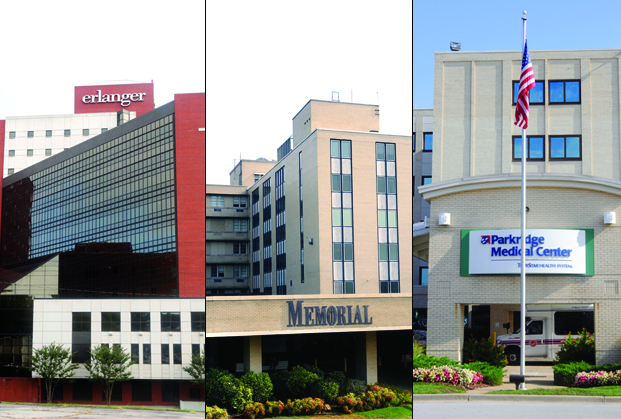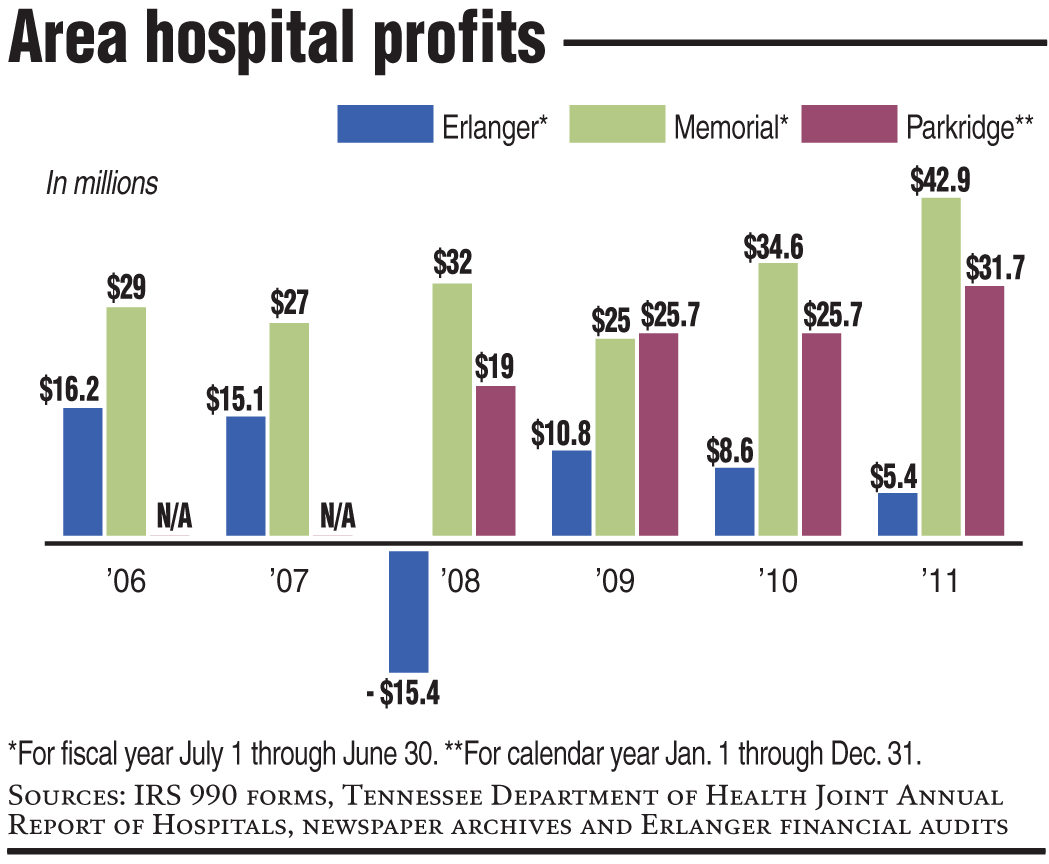BY THE NUMBERSTotal revenuesErlanger Memorial Parkridge2006 //$467 million //$378 million //N/A2007 //$499 million //$392 million //N/A2008 //$500 million //$424 million //$223 million2009 //$507 million //$445 million //$242 million2010 //$520 million //$468 million //$245 million2011 //$553 million //$526 million //$259 million
Erlanger and Memorial health systems claim similar shares of the Chattanooga market, and both operate as tax-exempt hospitals.
However, their bottom lines couldn't be more different.
Over the past six years, nonprofit Memorial experienced steady growth, bringing in $190 million in profits.
Meanwhile, Erlanger, the area's only Level 1 trauma center and the public safety-net hospital for indigent patients, saw steadily declining profits.
Last year alone, Memorial raked in a record $42.9 million -- more than the $40.7 million Erlanger made over the last six years. The gap likely will widen this year, with Erlanger losing more than $17 million so far.
The two hospitals have competed for market share in the past, but the most recent numbers show Memorial closing the gap in total revenue numbers and surpassing Erlanger in profits and expansions.
Parkridge Health System, the area's for-profit hospital, commands a smaller portion of market share but also saw an increase in revenues and profits.
R. Lawrence Van Horn, associate professor of economics and management at Vanderbilt University, called Memorial's earnings "very consistent" with what most nonprofit hospitals bring in.
"There's nothing exciting; there's no drama here," Van Horn said. "It looks like a solid, well-functioning, financially sound institution."
Memorial President James Hobson said the hospital's recent numbers are only a continuation of providing the type of care the faith-based hospital has delivered since it was founded. The hospital is owned by Denver-based Catholic Health Initiatives.
"We continue to focus on the key principles for what is important to us -- being the provider of choice for our patients and delivering high-quality, faith-based care," Hobson said. "It is who we are and what we're about."
COMMUNITY ROLES
As Memorial and Erlanger jockey to find their roles in a changing hospital landscape, the two organizations offer differing explanations of what their financial numbers mean.
Traditionally, along with trauma care, Erlanger has provided more neonatal and pediatric care at its children's hospital, while Memorial has a heart center and specialized cancer treatment.
Erlanger also sees more TennCare patients, who provide less government compensation than Memorial's higher percentage of Medicare patients.
In the last year, Erlanger's surgery numbers have declined as doctors moved the money-making treatments to other hospitals. Its CEO, Jim Brexler, resigned in December amid questions about his leadership, and interim leaders instituted several rounds of layoffs in an attempt to halt mounting losses.
As a public hospital, Erlanger receives a small amount of local public funding, getting $1.5 million from Hamilton County this year. Both hospitals are exempt from property, sales and business taxes, Memorial because of its nonprofit status and Erlanger because it's a public hospital.
Erlanger officials and board members point out that Erlanger provides more and more uncompensated care for the area. For fiscal year 2011, charity-care services cost Erlanger $24.4 million, compared with Memorial's $6.7 million in charity-care costs.
Britt Tabor, chief financial officer at Erlanger, said Erlanger's uncompensated costs will increase $10 million this year alone.
"Erlanger officials have always felt there should be a commitment level for providing direct patient care to the underserved population for not-for-profit hospitals," Tabor wrote in an email. "These additional costs do have a negative impact on Erlanger's bottom line and cash flow."
But Memorial's Hobson, who has headed the hospital since 2008, said Memorial provides community benefits that equal its tax breaks. Memorial may have lower charity-care numbers, he said, but it provides other community services that include health screenings and preventive care programs.
"All of those components are part of the significant community benefits we provide," Hobson said.
LOCAL PROFITS
As a nonprofit, all Memorial's profits go into increased growth in the Chattanooga area, Hobson said. The hospital pays less than 2 percent of its base operating expenses to Catholic Health Initiatives, which provides financial accounting, tax department, payroll and accounts payable services.
This year, Memorial announced it was spending more than $318 million to expand and upgrade both its Glenwood and Hixson hospitals over the next four years.
"We are keeping our faces toward the future," Hobson said. "There are a lot of changes and a lot of challenges, but hospitals will need to evolve in response to those changes."
Even though Memorial had significant profits, its margins are typical for nonprofit hospitals nationwide, Van Horn said.
For-profit hospitals usually have higher operating margins of 10 to 15 percent, with Parkridge falling into that range, he said.
In the last year six years, Memorial had operating margins of 2 to 4 percent profit, which are based on patient revenue. Nashville nonprofit hospitals usually have operating margins of 3 to 5 percent, Van Horn noted.
According to Thomson Reuters, a business analysis group, the average operating profit median of all U.S. hospitals increased from 3.8 percent to 5 percent over the last five years.
Van Horn said hospitals usually report operating margins, but he also looks at total margins, which include profit from investments and other revenue not directly related to patient care.
Memorial's total margins ranged from 5 to 8 percent from 2006 to 2011, with the highest being last year's 8.2 percent total margin.
Erlanger had declining total margins, dropping to just under 1 percent last year in comparison to 3.5 percent in 2006.
The fact that Memorial has been able to maintain such consistent numbers year after year is "very impressive," Van Horn said.

